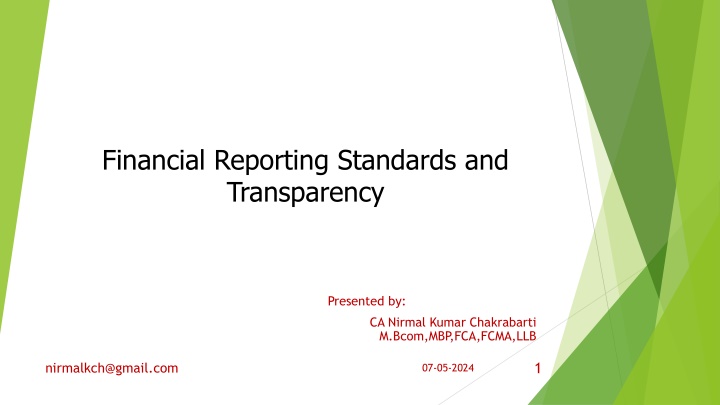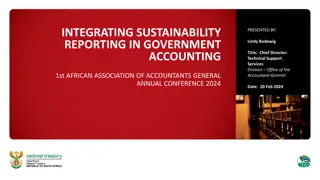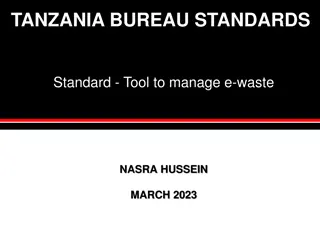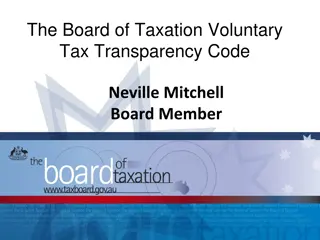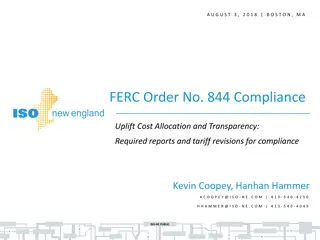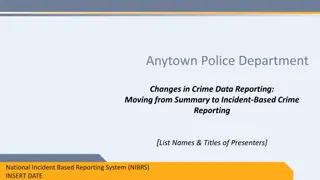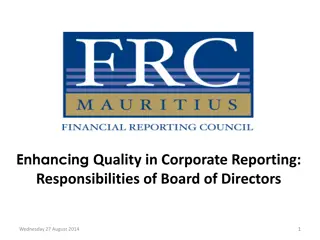Financial Reporting Standards and Transparency Overview
Financial Reporting Standards (ASLB) aim to improve the quality, consistency, and transparency of financial reporting by local bodies in India. ASLB guidelines cover the preparation and presentation of financial statements, accounting policies, revenue recognition, expenditure classification, and financial disclosures. Challenges in implementing ASLB include limited awareness and resources. Transparency in financial reporting enhances accountability, identifies financial irregularities, and ensures efficient resource management in local bodies.
Download Presentation

Please find below an Image/Link to download the presentation.
The content on the website is provided AS IS for your information and personal use only. It may not be sold, licensed, or shared on other websites without obtaining consent from the author.If you encounter any issues during the download, it is possible that the publisher has removed the file from their server.
You are allowed to download the files provided on this website for personal or commercial use, subject to the condition that they are used lawfully. All files are the property of their respective owners.
The content on the website is provided AS IS for your information and personal use only. It may not be sold, licensed, or shared on other websites without obtaining consent from the author.
E N D
Presentation Transcript
Financial Reporting Standards and Transparency Presented by: CA Nirmal Kumar Chakrabarti M.Bcom,MBP ,FCA,FCMA,LLB 1 nirmalkch@gmail.com 07-05-2024
Overview of Financial Reporting Standards (ASLB) and Transparency Introduction to Accounting Standards for Local Bodies (ASLB): ASLB are a set of AS issued by the Institute of Chartered Accountants of India (ICAI) specifically for local bodies such as municipal corporations, municipalities, and panchayats. Its aim to improve the quality, consistency, and transparency of financial reporting by local bodies. Applicability of ASLB: ASLB are applicable to all local bodies in India that are required to prepare financial statements in accordance with the provisions of the Constitution of India and relevant state laws. ASLB prescribe guidelines for the preparation and presentation of financial statements, including balance sheets, income expenditure statements, and cash flow statements. They also cover accounting policies, revenue recognition, expenditure classification, and financial disclosures. Benefits of ASLB in Local Bodies: ASLB improve the transparency and reliability leads better decision-making by stakeholders. They facilitate comparability of financial statements across different local bodies, enabling benchmarking and performance evaluation. 2 nirmalkch@gmail.com 21-02-2025
Challenges in Implementing ASLB: Limited awareness and understanding of ASLB among local body officials and accountants. Lack of capacity and resources to implement ASLB effectively, especially in smaller local bodies. Role of Transparency in Financial Reporting: 1. Transparency in financial reporting involves providing clear, accurate, and timely information about the financial performance and position of an organization. 2. It enhances accountability and helps in identifying and addressing financial irregularities or mismanagement. Initiatives to Improve Transparency: 1. The Government of India has introduced various initiatives to improve transparency in financial reporting by local bodies, such as mandatory audits by the Comptroller and Auditor General (CAG). 2. Training programs and capacity-building efforts are also being undertaken to enhance the understanding and implementation of ASLB. Outcome Adherence to Accounting Standards for Local Bodies (ASLB) and enhanced transparency in financial reporting are crucial for ensuring the efficient and accountable management of resources in local bodies in India. nirmalkch@gmail.com 21-02-2025 3
Accounting Standard for Local Bodies nirmalkch@gmail.com 21-02-2025 4
Background of ASLB( Accounting Standard for Local Body 73rd and 74th Constitutional Amendment Acts ion 1992 &1993 empower PRIs and ULBs in areas like education, health, rural housing, and water supply etc Definition of Local Body: Refers to local self-government entities at the third tier of governance, such as municipal corporations, municipalities, or panchayats. Delegation of Functions: Local Bodies may delegate functions like building schools, roads, parks, etc., to other bodies, which may or may not be controlled by them, such as development authorities or parastatals. 28 States/Union Territories agreed to adopt double entry accounting under Urban Reforms Incentive Fund (URIF). National Urban Renewal Mission mandates modern, accrual-based double entry accounting for Local Self Governments. Proposed Second Generation Reforms under URIF-II aim to further promote accrual-based double entry accounting among Local Self Governments. nirmalkch@gmail.com 21-02-2025 5
Background of ASLB( Accounting Standard for Local Body Shift to Accrual Basis of Accounting: Many Local Bodies are transitioning to accrual basis accounting, especially after the issuance of the National Municipal Accounts Manual (NMAM) by the Government of India, supported by various organizations. Diverse Accounting Policies: Despite the shift, Local Bodies follow diverse accounting policies and practices, leading to a need for a single set of high-quality financial reporting standards. Initiatives for Standardization: The Accounting Standards Board of the ICAI constituted a Sub-Committee in 1999 for issuing accounting standards for government, including urban local bodies. This led to the issuance of a Technical Guide on Accounting and Financial Reporting by Urban Local Bodies. Formation of CASLB: Recognizing the need for harmonization and improvement in accounting and financial reporting among Local Bodies, the Institute of Chartered Accountants of India (ICAI) establishedthe Institute of Chartered constituted a full-fledged Committee on Accounting Standards for Local Bodies (CASLB) in March 2005. nirmalkch@gmail.com 21-02-2025 6
The Conceptual Framework for General Purpose Financial Reporting by Local Bodies The Conceptual Framework guides the development of Accounting Standards for Local Bodies (ASLBs) for General Purpose Financial Reports (GPFRs). Users of GPFRs of local bodies require information for assessing: 1. Financial position 2. Resources controlled and restrictions on their use 3. Overall financial solvency 4. Efficiency and effectiveness in providing services to constituents 5. Ability to sustain efficient and effective service provision nirmalkch@gmail.com 21-02-2025 7
Non-exchange transactions involve entities giving or receiving value without direct exchange, common in local bodies. The level and quality of services received by individuals are not directly related to taxes assessed; they often pay fees or make contributions for services. These transactions are generally non-exchange because benefits obtained may not equal fees or contributions. Recognition, measurement, presentation, and disclosure of non-exchange transactions may vary to support assessments of the entity by service recipients and resource providers. nirmalkch@gmail.com 21-02-2025 8
(ASLB) 1 Presentation of Financial Statements Objective: The objective of this Standard is to ensure comparability of general purpose financial statements both within the entity s financial statements of previous periods and with the financial statements of other entities. Guidance and Requirements: It sets out overall considerations, guidance for structure, and minimum content requirements for financial statements prepared under accrual basis accounting. Recognition, Measurement, and Disclosure: Specific transactions and events are addressed in other Accounting Standards for Local Bodies (ASLBs). Applicability: This Standard applies to all general purpose financial statements prepared under accrual basis accounting in accordance with ASLBs. Differences from AS 1: ASLB 1 focuses on the presentation of financial statements, unlike the existing AS 1 (issued 1979), which primarily deals with the disclosure of accounting policies. ASLB 1 has a wider scope, making a line-by-line comparison with existing AS 1 impractical. nirmalkch@gmail.com 21-02-2025 9
(ASLB) 2 Cash Flow Statements Objective: The purpose of this standard is to mandate the disclosure of historical changes in an entity's cash and cash equivalents through a cash flow statement. This statement should categorize cash flows into operating, investing, and financing activities. Requirements :Entities following accrual accounting must adhere to this standard and include the cash flow statement as an integral component of their financial statements for each reporting period. nirmalkch@gmail.com 21-02-2025 10
Comparison with Existing AS 3, Cash Flow Statements ASLB 2 specifically included bank overdrafts which are repayable on demand as a part of cash and cash equivalents, whereas the existing AS 3 is silent on this aspect. 1. ASLB 2 does not address the insurance business or public financial institutions as these are not relevant to local bodies in India, whereas existing AS 3 includes provisions for these entities. 2. ASLB 2 omits provisions regarding the payment of dividends or similar distributions to owners, considering their irrelevance to local bodies, which are not applicable in AS 3. 3. Existing AS 3 mandates separate disclosure of cash flows from extraordinary items categorized by operating, investing, or financing activities, a requirement absent in ASLB 2. 4. ASLB 2 adjusts provisions concerning income taxes to align with the Income Tax Act, 1961, applicable to local bodies in India, unlike AS 3. 5. Unlike AS 3, ASLB 2 does not address cash flows from foreign controlled entities, which are not pertinent to local bodies in India. 6. ASLB 2 introduces a requirement for disclosure of cash and cash equivalents in controlled entities or operating units acquired or disposed of, a provision lacking in AS 3. nirmalkch@gmail.com 21-02-2025 11
(ASLB) 3 Accounting Policies, Changes in Accounting Estimates and Errors Objective:The objective of ASLB 3 is to establish criteria for selecting and changing accounting policies, as well as outlining the accounting treatment and disclosure of changes in policies, estimates, and error corrections. Requirements : ASLB 3 aims to improve the relevance, reliability, and comparability of an entity's financial statements over time and with those of other entities. Compaarision :In contrast, the objective of existing AS 5 is to regulate the classification and disclosure of specific items in the statement of profit and loss, ensuring uniformity in the preparation and presentation of financial statements. nirmalkch@gmail.com 21-02-2025 12
(ASLB) 9 Revenue from Exchange Transactions 1. This standard pertains to entities that prepare financial statements under the accrual basis and outlines guidelines for accounting revenue from specific exchange transactions and events. 2. Revenue covered includes that generated from: (a) providing services, (b) selling goods, and (c) others using entity assets resulting in interest, royalties, and dividends. 3. The standard applies to entities categorized as Local Bodies according to the Preface of the Accounting Standards for Local Bodies. 4. While Local Bodies may derive revenue from both exchange and non-exchange transactions, this standard focuses solely on revenue from exchange transactions, which involve selling goods or services to third parties, other government agencies, or using entity assets by others resulting in interest, royalties, or dividends. nirmalkch@gmail.com 21-02-2025 13
(ASLB) 12 Inventories 1. The objective of ASLB 12 is to prescribe the accounting treatment for inventories, focusing on determining the cost to be recognized as an asset and subsequently expensed when related revenues are recognized. 2. It provides guidance on cost determination, expense recognition, including write-down to net realizable value, and cost formulas for assigning costs to inventories. 3. ASLB 12 addresses subsequent recognition of inventory cost/carried amount as an expense, a feature not found in existing AS 2. 4. ASLB 12 covers valuation of inventories acquired through non-exchange transactions, whereas existing AS 2 does not address transactions related to exchange or distribution. 5. ASLB 12 includes guidance on the reversal of inventory write-downs to net realizable value up to the original write-down amount, and the recognition and disclosure of such reversals, which is absent in existing AS 2. nirmalkch@gmail.com 21-02-2025 14
5. ASLB 12 employs a distinct inventory definition from existing AS 2, acknowledging that some inventories in local bodies are distributed at no cost or for a nominal fee. 6. It encompasses the valuation of work-in-progress for services provided by local bodies, except when no or nominal compensation is expected directly from recipients, a contrast to AS 2, which excludes such work-in-progress for service providers. 7. ASLB 12 mandates that inventories provided at no cost or for a nominal fee should be valued at the lower of cost and current replacement cost. Existing AS 2 does not address this scenario, thus providing no guidance. ASLB 12 also defines 'current replacement cost' in alignment with this requirement. nirmalkch@gmail.com 21-02-2025 15
(ASLB) 17 Property, Plant and Equipment 1. The objective of this standard is to prescribe the accounting treatment for property, plant, and equipment to provide financial statement users with information regarding an entity's investment in these assets and changes therein. 2. Key issues addressed include the recognition of assets, determination of their carrying amounts, and the accounting for depreciation charges and impairment losses related to them. 3. Entities following accrual accounting must adhere to this standard, except when a different treatment is specified by another Accounting Standard for Local Bodies or concerning heritage assets. 4. This standard applies to entities categorized as local bodies as described in the Preface to the Accounting Standards for Local Bodies. 5. Depreciation to be charged as per life of the assets nirmalkch@gmail.com 21-02-2025 16
(ASLB) 23 Revenue from Non-Exchange Transactions (Taxes and Transfers) This Standard addresses revenue arising from non-exchange transactions. Revenue arising from exchange transactions is addressed in ASLB 9, Revenue from Exchange Transactions . While revenues received by local bodies arise from both exchange and nonexchange transactions, the majority of revenue of local bodies is typically derived from non-exchange transactions such as: (a) Taxes; and (b) Transfers (whether cash or non-cash), including grants, debt forgiveness, fines, gifts, donations, and goods and services in-kind. An entity that prepares and presents financial statements under the accrual basis of accounting should apply this Standard in accounting for revenue from non- exchange transactions. This Standard does not apply to an entity combination that is a nonexchange transaction. nirmalkch@gmail.com 21-02-2025 17
(ASLB) 24 Presentation of Budget Information in Financial Statements 1. This standard mandates that entities publicly disclosing their approved budgets must include a comparison of budgeted amounts with actual figures in their financial statements. 2. It also requires the disclosure of explanations for significant differences between budgeted and actual amounts. 3. Compliance ensures that entities fulfill their accountability obligations and improves financial statement transparency. 4. It demonstrates adherence to approved budgets and, when budgets and financial statements are prepared on the same basis, showcases financial performance in achieving budgeted results. nirmalkch@gmail.com 21-02-2025 18
ASLB 33, First-Time Adoption of Accrual Basis Accounting Standards for Local Bodies 1. The objective of this standard is to guide first-time adopters transitioning to accrual basis ASLBs in presenting high-quality financial information. 2. It aims to ensure transparent reporting of the transition process, establish a suitable starting point for accrual basis accounting, and ensure that benefits outweigh costs. 3. Entities should apply this standard when preparing annual financial statements upon adoption of, and during the transition to, accrual basis ASLBs. 4. This standard applies to all entities categorized as Local Bodies according to the 'Preface to the Accounting Standards for Local Bodies.' nirmalkch@gmail.com 21-02-2025 19
(ASLB) 42, Social Benefits Objective: Guide first-time adopters transitioning to accrual basis ASLBs. Ensure transparent reporting of transition, establish suitable starting point for accrual basis accounting. Apply standard during preparation of annual financial statements upon adoption of, and during transition to, accrual basis ASLBs. Applicable to all entities categorized as Local Bodies according to 'Preface to the Accounting Standards for Local Bodies'. To accomplish that, this ASLB establishes principles and requirements for: (a) Recognizing expenses and liabilities for social benefits; (b) Measuring expenses and liabilities for social benefits; (c) Presenting information about social benefits in the financial statements; and (d) Determining what information to disclose to enable users of the financial statements to evaluate the nature and financial effects of the social benefits provided by the reporting entity. nirmalkch@gmail.com 21-02-2025 20
The Importance of the Approved Budget: Local bodies typically prepare budgets, which are made publicly available as required by relevant legislation. Legislation often defines the contents of budget documentation. Elected representatives, comprising the governing body, oversee and hold management financially accountable through the budget and other mechanisms. The approved budget often serves as the basis for setting taxation levels and obtaining approval for spending from the governing body. The Regulatory Role of Local Bodies: Local bodies prepare budgets, publicly available per legislation. Legislation defines budget documentation contents. Elected representatives oversee and hold management financially accountable. Approved budget sets taxation levels and obtains spending approval. nirmalkch@gmail.com 21-02-2025 21
Applicable Accounting Standards as per Institute of Chartered Accountants of India 22 nirmalkch@gmail.com 21-02-2025
AS-1 : Disclosure of Accounting Policies AS-1 deals with Accounting Policies, its meaning, selection bases, disclosures, changes in accounting policies and fundamental accounting assumptions Accounting Policy: They are specific accounting principles used by an entity and method of applying those principles in preparation and presentation of FS. Fundamental Accounting Assumptions: Going Concern Accrual Consistency If fundamental accounting assumptions are followed then no disclosure required, if not followed, then disclosure with reason and effect is mandatory. nirmalkch@gmail.com 21-02-2025 23
AS-2 : Valuation of Inventories A primary issue in accounting for inventories is the determination of the value at which inventories are carried in the financial statements until the related revenues are recognised. This Standard deals with the determination of such value, including the ascertainment of cost of inventories and any write-down thereof to net realisable value. nirmalkch@gmail.com 21-02-2025 24
AS 3 : Cash Flow Statements Information about the cash flows of an enterprise is useful in providing users of financial statements with a basis to assess the ability of the enterprise to generate cash and cash equivalents and the needs of the enterprise to utilise those cash flows. The economic decisions that are taken by users require an evaluation of the ability of an enterprise to generate cash and cash equivalents and the timing and certainty of their generation. The Standard deals with the provision of information about the historical changes in cash and cash equivalents of an enterprise by means of a cash flow statement which classifies cash flows during the period from operating, investing and financing activities. nirmalkch@gmail.com 21-02-2025 25
AS 10 : Property, Plant and Equipment The objective of this Standard is to prescribe the accounting treatment for property, plant and equipment so that users of the financial statements can discern information about investment made by an enterprise in its property, plant and equipment and the changes in such investment. The principal issues in accounting for property, plant and equipment are the recognition of the assets, the determination of their carrying amounts and the depreciation charges and impairment losses to be recognized in relation to them. nirmalkch@gmail.com 21-02-2025 26
AS 12: Government Grants 1. Definition of Government Grants: Government grants, also known as subsidies, cash incentives, duty drawbacks, etc., are addressed in this Standard. 2. Exclusions: This Standard does not cover accounting for government grants in financial statements affected by changing prices, other forms of government assistance, or government ownership of the enterprise. 3. Significance of Government Grants: 1. Accounting: Proper accounting methods are needed for government grants received by an enterprise. 2. Benefit Indication: It's important to indicate how much the enterprise has benefited from the grant in the reporting period. 4. Purpose: 1. Comparison: Helps in comparing an enterprise's financial statements over different periods and with those of other enterprises. nirmalkch@gmail.com 21-02-2025 27
THANK YOU nirmalkch@gmail.com 21-02-2025 28
